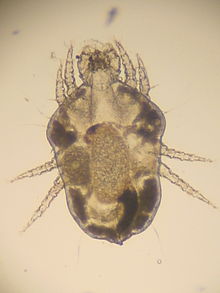
Mites are small arachnids. Mites span two large orders of arachnids, the Acariformes and the Parasitiformes, which were historically grouped together in the subclass Acari. However, most recent genetic analyses do not recover the two as each other's closest relative within Arachnida, rendering the group non-monophyletic. Most mites are tiny, less than 1 mm (0.04 in) in length, and have a simple, unsegmented body plan. The small size of most species makes them easily overlooked; some species live in water, many live in soil as decomposers, others live on plants, sometimes creating galls, while others again are predators or parasites. This last type includes the commercially destructive Varroa parasite of honey bees, as well as scabies mites of humans. Most species are harmless to humans, but a few are associated with allergies or may transmit diseases.

Acaricides are pesticides that kill members of the arachnid subclass Acari, which includes ticks and mites. Acaricides are used both in medicine and agriculture, although the desired selective toxicity differs between the two fields.

The discipline of medical entomology, or public health entomology, and also veterinary entomology is focused upon insects and arthropods that impact human health. Veterinary entomology is included in this category, because many animal diseases can "jump species" and become a human health threat, for example, bovine encephalitis. Medical entomology also includes scientific research on the behavior, ecology, and epidemiology of arthropod disease vectors, and involves a tremendous outreach to the public, including local and state officials and other stake holders in the interest of public safety.
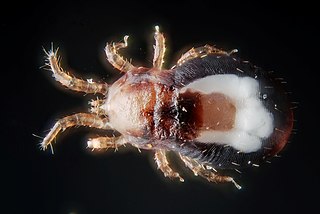
Dermanyssus gallinae is a haematophagous ectoparasite of poultry. It has been implicated as a vector of several major pathogenic diseases. Despite its common names, it has a wide range of hosts including several species of wild birds and mammals, including humans. In both size and appearance, it resembles the northern fowl mite, Ornithonyssus sylviarum.

Cheyletidae is a family of mites in the order Trombidiformes. Some members are parasites of birds and mammals, causing cheyletiellosis, or "walking dandruff". Others are free-ranging predators which can be found in soil, forest litter, animal nests, and house dust, under tree bark, and on foliage.

Psoroptes is a genus of mites, including the agents that cause psoroptic mange.

The flour mite, Acarus siro, a pest of stored grains and animal feedstuffs, is one of many species of grain and flour mites. An older name for the species is Tyroglyphus farinae.

Trombiculidae ; commonly referred to in North America as chiggers and in Britain as harvest mites, but also known as berry bugs, bush-mites, red bugs or scrub-itch mites, are a family of mites. Chiggers are often confused with jiggers – a type of flea. Several species of Trombiculidae in their larva stage bite their animal or human host and by embedding their mouthparts into the skin cause "intense irritation" or "a wheal, usually with severe itching and dermatitis".
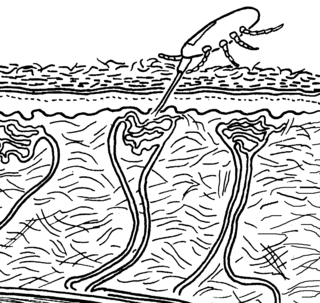
Gamasoidosis, or dermanyssosis, is a frequently unrecognized ectoparasitosis and source of growing concern in human medicine, occurring after contact with avian mites which infest canaries, sparrows, starlings, pigeons and poultry and caused by two genera of mites, Ornithonyssus and Dermanyssus. Avian mite species implicated include the red mite, tropical fowl mite and northern fowl mite . Mite dermatitis is also associated with rodents infested with the tropical rat mite, spiny rat mite and house-mouse mite, where the condition is known as rodent mite dermatitis. Urban gamasoidosis is associated with window-sills, ventilation and air-conditioning intakes, roofs and eaves, which serve as shelters for nesting birds. Humans bitten by these mites experience a non-specific dermatitis with intense itching.

Pyemotes tritici is a species of mite known as the grain itch mite or straw itch mite. It is a cosmopolitan species that is found on straw, hay and stored grain. It is a parasite of small arthropods and is being investigated as a possible biological control of stored product pests. It is associated with dermatitis in humans, and it causes an itchy rash.
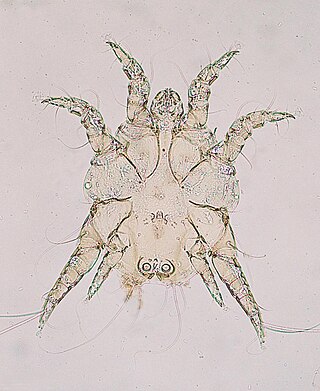
Psoroptidae is a family of parasitic mites, which are 1–2 mm (0.039–0.079 in) long and live on the surface of the skin, rather than burrowing into it. These mites affect various species, including cats, dogs, rabbits, cattle, sheep, and horses, causing skin inflammation, scabs, crusting, and hair loss.

Androlaelaps casalis formerly known as Haemolaelaps casalis is a species of predatory mite that feeds on other mites and small invertebrates. It cannot bite or sting birds and humans because its mandibles are not designed for sucking but for predation on other mites. Because Androlaelaps casalis mites feed off parasitic mites like Dermanyssus gallinae, individuals with red colored abdomens can be found. This is not due to any blood-sucking by A. casalis but is because it has ingested blood-engorged parasitic mites. There is some evidence that it may be associated with dermatitis in humans.
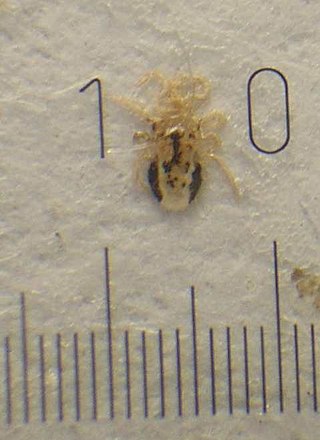
Ornithonyssus sylviarum is a haematophagous ectoparasite of poultry. In both size and appearance, it resembles the red mite, Dermanyssus gallinae.
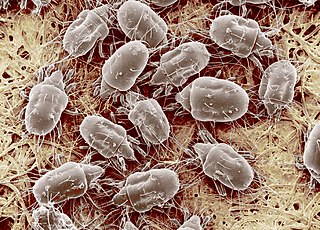
Tyrophagus putrescentiae is a cosmopolitan mite species. Together with the related species T. longior, it is commonly referred to as the mould mite or the cheese mite. The name translates from Greek to something like "putrid cheese eater."

Mites that infest and parasitize domestic animals cause disease and loss of production. Mites are small invertebrates, most of which are free living but some are parasitic. Mites are similar to ticks and both comprise the order Acari in the phylum Arthropoda. Mites are highly varied and their classification is complex; a simple grouping is used in this introductory article. Vernacular terms to describe diseases caused by mites include scab, mange, and scabies. Mites and ticks have substantially different biology from, and are classed separately from, insects. Mites of domestic animals cause important types of skin disease, and some mites infest other organs. Diagnosis of mite infestations can be difficult because of the small size of most mites, but understanding how mites are adapted to feed within the structure of the skin is useful.
Demodex bovis, also known as the cattle follicle mite, usually causes demodicosis, or demodectic mange, in cattle. This disease is common in tropical areas and is not usually found in temperate environments. Demodicosis is characterized by the formation of papules and nodules over the cattle's skin. These lesions most commonly occur on the neck, shoulders, and armpit of cattle; however, sometimes they also appear on the udder. This condition is often found in cattle with increased stress from pregnancy or lactation. Natural and acquired immunity can cause a decrease in the number of mites infesting a cow, as well as decreasing the severity of a cow's symptoms.

Mites are small crawling animals related to ticks and spiders. Most mites are free-living and harmless. Other mites are parasitic, and those that infest livestock animals cause many diseases that are widespread, reduce production and profit for farmers, and are expensive to control.
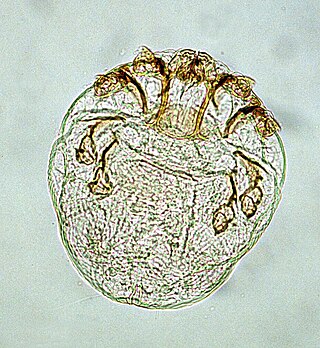
Knemidokoptes is a genus of parasitic mites in the family Epidermoptidae that infect the skin or feather follicles of birds, especially gallinaceous birds as well as parakeets and canaries. Infection commonly causes scaly lesions to form at the face or feet, which is known as knemidocoptiasis.
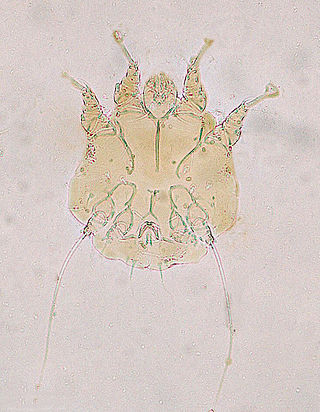
Notoedric mange, also referred to as Feline scabies, is a highly contagious skin infestation caused by an ectoparasitic and skin burrowing mite Notoedres cati. N. cati is primarily a parasite of felids, but it can also infest rodents, lagomorphs, and occasionally also dogs and foxes. This skin disease also has zoonotic potential. Infestation is also called acariasis, which refers to a rash that is caused by mites.
Mercedes Delfinado is an acarologist from the Philippines, who was a recipient of a 1962 Guggenheim Fellowship. She is a specialist in bee mites, and published widely on insects of south-east Asia. For over twenty years she was a Chief Editor for the International Journal of Acarology. Multiple species were named in her honour.
